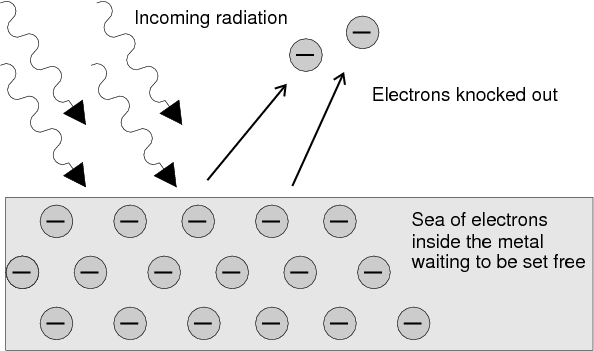| << Chapter < Page | Chapter >> Page > |
Around the turn of the twentieth century, it was observed by a number of physicists (including Hertz, Thomson and Von Lenard) that when light was shone on a metal, electrons were emitted by the metal. This is called the photoelectric effect. ( photo - for light, electric - for the electron.)
The photoelectric effect is the process whereby an electron is emitted by a metal when light shines on it.
At that time, light was thought to be purely a wave. Therefore, physicists thought that if a more intense (i.e. brighter) light was shone on a metal, then the electrons would be knocked out with greater kinetic energies than if a faint light was shone on them. However, Von Lenard observed that this did not happen at all. The intensity of the light made no difference to the kinetic energy of the emitted electrons! Also, it was observed that the electrons were emitted immediately when light was shone on the metal - there was no time delay.
Einstein solved this problem by proposing that light is made up of packets of energy called quanta (now called photons) which interacted with the electrons in the metal like particles instead of waves. Each incident photon would transfer all its energy to one electron in the metal. For a specific colour of light (i.e. a certain wavelength or frequency), the energy of the photons is given by , where is Planck's constant. The energy needed to knock an electron out of the metal is called the work function (symbol ) of the metal. Therefore, the amount of energy left over as the kinetic energy ( ) of the emitted electron would be the difference between the incoming photon's energy and the energy needed to knock out the electron (work function of the metal):
Increasing the intensity of the light (i.e. making it brighter) did not change the wavelength of the light and therefore the electrons would be emitted with the same kinetic energy as before! This solved the paradox and showed that light has both a wave nature and a particle nature . Einstein won the Nobel prize for this quantum theory and his explanation of the photoelectric effect.
Increasing the intensity of the light actually means increasing the number of incident photons. Therefore, since each photon only gives energy to one electron, more incident photons means more electrons would be knocked out of the metal, but their kinetic energies would be the same as before.

The photoelectric effect was first observed in the experiments of Heinrich Hertz in 1887. In 1899 J.J. Thomson proved that it was electrons that were emitted. The photoelectric effect was theoretically explained by Albert Einstein in 1905.
The discovery and understanding of the photoelectric effect was one of the major breakthroughs in science in the twentieth century as it provided concrete evidence of the particle nature of light. It overturned previously held views that light was composed purely of a continuous transverse wave. On the one hand, the wave nature is a good description of phenomena such as diffraction and interference for light, and on the other hand, the photoelectric effect demonstrates the particle nature of light. This is now known as the `dual-nature' of light. (dual means two)

Notification Switch
Would you like to follow the 'Siyavula textbooks: grade 12 physical science' conversation and receive update notifications?